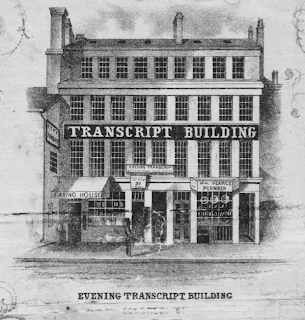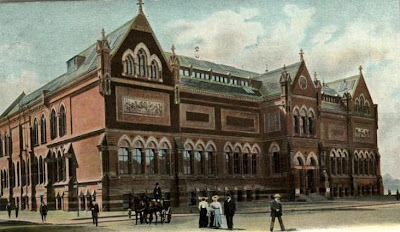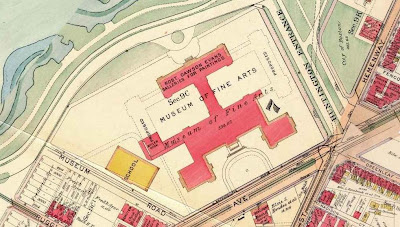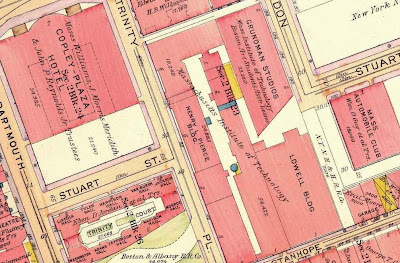
J.H. Colton & Co. 1855 (BPL). (click on map for larger image). Approximate path of today's Melnea Cass blvd. marked in red.
Every so often, a news item will locate a particular address as being in the South End or Roxbury, and people will argue for one or the other. Of course, today the various districts of the City of Boston have no official boundaries between each other. In some cases, City Hall has been historically careful to not define boundaries, for fear of offending residents - and losing votes.
We can, however, start with the knowledge that there once were official boundaries between the various towns that were annexed to Boston during the 19th and early 20th Century. While the towns of Brighton and Charlestown are mostly isolated from the rest of the city, Dorchester, Roxbury and the short-lived town of West Roxbury did share defined borders. While districts like Jamaica Plain and Roslindale were never legally separate (nor Dorchester and Mattapan), when we are dealing with two communities that were once separate municipalities, we can use history to give us provisional boundaries, at least.
Before the land around Boston Neck was filled in during the 19th Century, the town ( and then city) of Boston was essentially an island connected to the mainland by a thin strip of land at Roxbury. The new, filled land on either side of Boston Neck was named the South End, and in time blended seamlessly with the adjacent lands of lower Roxbury.
Roxbury (recently having changed from town to city) was annexed to Boston in 1868. Fortunately for us (or at least those of us who care about such things), we have maps available from then-recent years. A section of one of those maps is shown above. The boundary between Roxbury and the still-expanding South End of Boston is clearly shown.
Please note Harrison and Shawmut avenues and Washington street (and Tremont street, unlabeled) coming down through the Neck from upper right towards lower left. At a right angle to those streets, near the mainland of Roxbury is Northampton street and Chester street, including the green of Chester square. For reference, Chester street is now Massachusetts avenue.
Now we can see that the border at the time followed Kendall street - or rather a stream just south of Kendall street. Luckily for us, Kendall street still exists, running at an angle between Shawmut and Tremont streets. That won't mean anything to anyone but a local resident, but Kendall and Shawmut street are now two blocks north of Melnea Cass boulevard. Kendall now empties out on to Lenox street, which is about seven short blocks north of Melnea Cass blvd. on Tremont street. On
So now we know where the mid-19th Century line was drawn between Roxbury and Boston's South End. However, we need to allow some slack for the intervening years in two ways. First, Melnea Cass blvd. was laid out over the path of the notorious and never-built Inner Belt highway that was to join the Southeast Expressway with I-93 in Somerville. When properties were taken for that project, entire blocks were torn down, and the neighborhood re-made. Given the width of Melnea Cass and the barrier it creates to pedestrian travel, I think we could be pragmatic and say that the two communities are now separated by four lanes of traffic by this road.
A second issue to consider is neighborhood opinion. If the people who live north of Melnea Cass think they live in Roxbury, can we tell them they are wrong? It depends. That is, it depends on whether a consensus has formed for a new boundary. This area has long been home to a relatively transient population. That is, few residents born there in the first half of the 20th Century probably live there now. Thus, an oral tradition of location identity may have been lost over generations.
Ultimately, if the local residents think they live in Roxbury, who are we to say otherwise. It has been 140 years since Roxbury was annexed - and the border eliminated - so nothing can be carved in stone. Still, we can point to solid evidence, and hope that history will be respected. Regardless of Zip codes or parking permit districts (or real estate weasels and landlords trying to pump up property values), Roxbury is Roxbury, and the South End is the South End. It would be nice if the historical difference between the two could be recognized and respected.





















